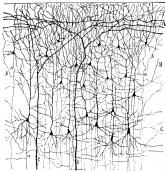In silico learning
Scientists at the Bernstein Centre for Computational Neuroscience, the University of Freiburg and RIKEN Brain Science Institute in Tokyo are investigating learning processes by simulating one cubic millimetre of the brain.

The
classical picture of a neuronal network such as can be found in the
cerebral cortex. The picture was drawn by the Spanish neuroanatomist
Ramon y Cajo, who was awarded the Nobel Prize in 1906 for his work.
(Photo: Kindly provided by Ad Aertsen)
The brain’s learning ability comes from the special properties of
neurones, particularly their connections (synapses). All brain activity
is mediated by information in the form of short electric impulses that
are passed from one ‘firing’ cell to the next. In so doing, the cells
cultivate their capability to propagate signals. If cell A emits a
pulse that evokes a response in cell B, this strengthens the contact
between the two cells. If there is no such causal relationship, or if
cell B fires before cell A, the connection is weakened. As a result of
this phenomenon, known as “spike-timing dependent plasticity” (STDP),
frequent pairings cause strong neural pathways to develop. Conversely,
connections which are infrequently used decline.

Abigail
Morrison, the first author of the published study, was able to show
that the basics of learning processes in the nerve cells are more
complex than hitherto assumed. (Photo: Morrison)
This “plasticity” of the brain, its ability to adapt physiologically
and structurally, is considered to be the foundation of learning. On
the basis of a complex computer simulation of 100,000 neurones with
10,000 contacts each – corresponding to about one cubic millimetre of
cortex - Abigail Morrison, Ad Aertsen and Markus Diesmann have
discovered that STDP may be insufficient to explain the learning
processes of nerve cells. The scientists’ results will be published in
the June issue of Neural Computation.
From earlier studies the researchers knew that their computer simulation reproduced many dynamic properties of the brain.
From earlier studies the researchers knew that their computer simulation reproduced many dynamic properties of the brain.
The virtual neurones fire at about the same frequency as they do in the
brain, and the level of activity neither rises nor falls – the system
maintains a “dynamic equilibrium”. The scientists have extended their
model to take into account the plasticity of neuronal connections. To
this end, Morrison developed a mathematical formulation of the STDP
learning rule that was far better able to describe the experimental
results. Thus, the model comes even closer to reality.
To investigate whether the computer model can simulate learning
processes, the researchers repeatedly stimulated a specific group of
neurones. Their initial observations agreed with the learning model
predictions: As the stimulated neurones transmitted the stimuli to
their downstream neurones, these contacts were strengthened. However,
this occurred at the expense of contacts from the upstream neurones in
the network. As the stimulated group responded to the external
stimulus, the other inputs became redundant and decayed. After a while,
the researchers determined that the entire stimulated group had
decoupled itself from the rest of the network.
STDP is therefore not sufficient for explaining the process of learning in large neuronal networks as additional requirements must be satisfied in order to enable the system to learn. There are already strong indications as to what these requirements might be. With the simulation of large networks, Morrison and colleagues have a powerful tool for appraising a variety of different models and uncovering the secret of neural learning.
Publication: Morrison, A., Aertsen, A., & Diesmann, M. (2007). Spike-timing dependent plasticity in balanced random networks. Neural Computation, 19 (6) 1437-1467
Source: University of Freiburg - 25 April 2007
STDP is therefore not sufficient for explaining the process of learning in large neuronal networks as additional requirements must be satisfied in order to enable the system to learn. There are already strong indications as to what these requirements might be. With the simulation of large networks, Morrison and colleagues have a powerful tool for appraising a variety of different models and uncovering the secret of neural learning.
Publication: Morrison, A., Aertsen, A., & Diesmann, M. (2007). Spike-timing dependent plasticity in balanced random networks. Neural Computation, 19 (6) 1437-1467
Source: University of Freiburg - 25 April 2007
Further information:
Prof. Dr. Ad Aertsen
Bernstein Centre for Computational Neuroscience
University of Freiburg
Phone: +49 (0)761/203-9549
E-mail: ad.aertsen@biologie.uni-freiburg.de
Dr. Abigail Morrison
Diesmann Research Unit
Computational Neuroscience Group
RIKEN Brain Science Institute
2-1 Hirosawa
Wako City, Saitama 351-0198, Japan
Phone: +81 48 467 9644
E-Mail: Abigail@brain.riken.jp
Prof. Dr. Ad Aertsen
Bernstein Centre for Computational Neuroscience
University of Freiburg
Phone: +49 (0)761/203-9549
E-mail: ad.aertsen@biologie.uni-freiburg.de
Dr. Abigail Morrison
Diesmann Research Unit
Computational Neuroscience Group
RIKEN Brain Science Institute
2-1 Hirosawa
Wako City, Saitama 351-0198, Japan
Phone: +81 48 467 9644
E-Mail: Abigail@brain.riken.jp





